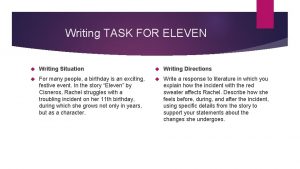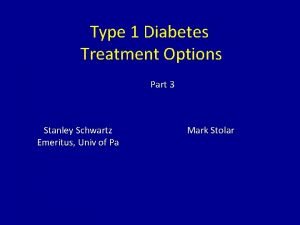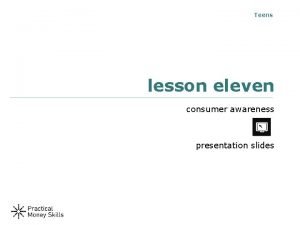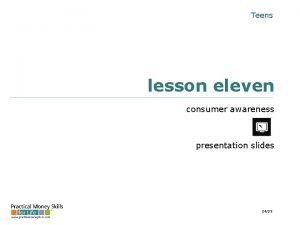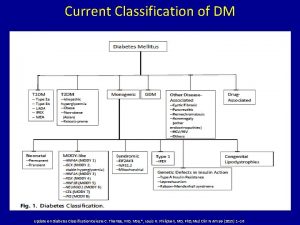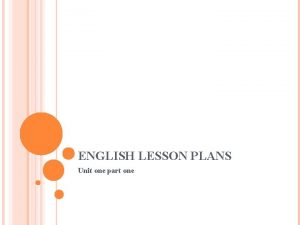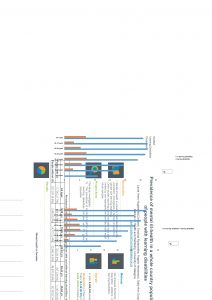Eleven years of research in Victoria Dr Frank



































- Slides: 35

Eleven years of research in Victoria Dr Frank Lambrick, Senior Practitioner - Disability Department of Health and Human Services Frank. Lambrick@dhhs. vic. gov. au

Outline of presentation 1. The Victorian Senior Practitioner role, functions and powers 2. Where our data comes from 3. Key activities 4. Research activity over the years 5. Current and future projects 2

Senior Practitioner role Under the Disability Act (2006) the Senior Practitioner is responsible for protecting the rights of persons who are subject to restrictive interventions and compulsory treatment: • Evaluate and monitor use of compulsory treatment and restrictive interventions • Develop guidelines and standards • Provide education and advice • Undertake research • Develop links with academia and professional bodies 3

Powers of the Senior Practitioner • Visit premises where a disability service is being provided • See any person who is subject to a restrictive intervention or compulsory treatment • Investigate, audit and monitor the use of restrictive interventions and compulsory treatment • Inspect or take copies of documents relating to a person subject to a restrictive intervention or compulsory treatment • See any person involved in the development of a restrictive intervention or compulsory treatment 4

Powers of the Senior Practitioner cont. • Request information from a disability service provider relating to a restrictive intervention or compulsory treatment • Authorise by written order the use of a restrictive intervention • Discontinue or alter practice • Direct a disability provider to observe or carry out a practice • Provide assistance if required to discontinue or alter practice 5

RIDS 6

Senior Practitioner day to day activities Behaviour Support Plans • Restrictive interventions must be included in an approved BSP, outside of emergency provision. • A minimum of 10 percent of BSPs are reviewed using the Behaviour Support Plan Quality Evaluation II Tool (BSP QE II) (Browning-Wright et al. , 2003) • A minimum of 5 percent of BSPs are subject to a further legislative and clinical review. • Feedback is sent to service providers and poor plans are subject to repeat evaluations and follow up. 7

Senior Practitioner day to day activities Restrictive Intervention Audit Reviews • The Senior Practitioner has the power to investigate, audit and monitor the use of restrictive interventions and compulsory treatment. • Regular audits of group homes, respite facilities and day programs. • Feedback is provided to the Authorised Program Officer and to each person with a disability receiving a service at the time of the audit outlining clarification or corrective actions required. 8

Senior Practitioner day to day activities Compulsory Treatment • Monitoring and oversight of people with a disability who are detained for the purposes of treatment as they pose a significant risk of harm to others. • Supervision of the implementation of treatment through monitoring the approved treatment plan and ensuring it will be of benefit to the person. • VCAT determines whether a Treatment Plan is appropriate having regard to specific criteria and may confirm or vary a Treatment Plan. 9

Restrictive Intervention Self-Evaluation Tool (RISET) An on-line learning tool for people interested in restrictive interventions 10

Senior Practitioner report 2016– 17

Total number of people who were reported to be subjected to restrictive interventions 2008 -17 12

Total number of people subject to restraint types 2008 -2017. 13

Quality of behaviour support plans 2012 -2017 14

Research activities over 11 years …. A strong applied research agenda: • Data collected informs policy and practice • Findings reported back to service providers at local meetings and national conferences • Findings used to make structural changes to RIDS to improve reporting and build capacity with service providers • Sponsoring of large research grants of up to $50, 000 and $2000 small scale projects for service providers

Behaviour Support Plans Research questions (2008 -2012 Four research papers): Is the BSP-QE II tool reliable and valid quality indicator for adults with a disability in Australia? What is the relationship between quality behaviour support plans and restrictive interventions? What we found: The BSP-QE II is a reliable and valid quality tool for use for adults with a disability in Australia. A positive association between the quality of a behaviour support plan as assessed by the BSP-QE II and the use of PRN restrictive interventions was found. 16

Chemical restraint Research question: A review of chemical restraint use of former Kew Residential Services residents (2008). What we found: Reviewed past psychiatric diagnoses and the relationship with ASD and found: 1. A need for regular psychiatric review and ongoing psychiatric management, 2. A difference between typical versus atypical antipsychotic medication, 3. Lack of resources and poor access to mental health services. 17

Chemical restraint 18

Chemical restraint Research question: Disability, mental health and medication: Implications for practice and policy (2011) What we found: • 98% of people were reported as being prescribed psychotropic medication, either regularly or when required on a pro re nata (prn) basis. • 43% reported to have a current or previous mental health diagnosis. • 88% were determined to be in need of independent psychiatric review according to consensus views of the psychiatrist and pharmacist. 19

Chemical restraint 20

Mechanical restraint Research question: What are the risk factors associated with the use of mechanical restraint? (2012 -2013) What we found: • Individuals with certain characteristics, e. g. hearing, physical, neurological, communication or visual impairment, and autism had an increased likelihood of being mechanically restrained. • Initiatives to reduce mechanical restraint should pay particular attention to the support needs of those with sensory impairments and complex communication support needs including those with autism and those with a physical impairment. 21

Seclusion Research question: What are the risk factors associated with the use of seclusion (2010 -2013)? What we found: Individual factors of age, the presence of autism and/or a psychiatric disorder put people at risk of being secluded. Receiving accommodation services in institutions or in the community and the location of the organisation were risk factors. The findings are consistent with previous research but add to this literature by showing that certain organisational characteristics are also risk factors for seclusion. 22

Physical restraint Research question: Physical restraint in disability services - current practices, contemporary concerns, and future directions. What we found: A review of the literature into physical restraint found contemporary world’s best practice in support of people with disability who exhibit behaviours of concern is informed and directed by ethical, clinical and legal imperatives to at least minimise, and in many circumstances eliminate the use of restraint and seclusion. 23

Physical restraint 24

Compulsory treatment Research question: The use of restrictive interventions in Compulsory Treatment (2008 -2009). What we found: • Similar rates of chemical and mechanical restraint use • Those on a CT were more likely to experience the use of seclusion than those who were not on CT • Similar proportion of people who were prescribed chemical restraint. • The types of medications used as chemical restraint differed (higher rate of people who were administered anti-libidinal medications in CT group) 25

Compulsory treatment Research question: Accommodation changes and characteristics of people with an intellectual disability under compulsory treatment in Victoria (19972014). What we found: Two broad types of service users within the CT system: • a younger group with a more unstable presentation whose active offending cycle leads to a higher likelihood of future imprisonment • an older group currently supported within shared supported accommodation whose offences are more historical and presentation more stable 26

Restrictive interventions (general) Research question: What is the cost of using restrictive interventions? What we found: A review of the literature revealed costs included both physical injuries to both staff and clients as well as cost of staff leave and client cost of lack of trust towards staff and reputational costs to organisations who use restrictive interventions. 27

Restraint reduction Research question: What is the impact of positive behaviour support on staff and the people they support (2012 -2014)? What we found: Disability staff participated in a training program based on the principles of PBS, which included elements of good practice as recommended in the BSP-QE II. Behaviour Support Plan (BSP) quality and client outcomes were evaluated and compared with a matched control group. Evaluation outcome data showed an improvement in the BSP quality and client mental health, reductions in maladaptive behaviours and restrictive intervention use. 28

Restraint reduction Research question: An effective organisational framework for the reduction in the use of restrictive practices: The Roadmap for the Reduction of Restrictive Practices in Victoria (2011 -2013). What we found: • A pilot was undertaken with three services to assess outcomes for clients whose staff had participated in Roadmap training. • Upward trends found in formal measurement indicating that the Roadmap is an essential ‘compass’ that can be adopted and used by organisations to create freedoms for people with a disability. • Qualitative results suggest staff were able to successfully reconceptualise what was acceptable and unacceptable behaviour. 29

Research projects under completion • Who is at risk of being chemically restrained with antipsychotics? • What are the specific local factors which lead to intervention recommendations for reducing mechanical restraint being maximally implemented by staff? • Long-term use of restrictive interventions: Who is at risk and what are protective factors? • The impact of the Roadmap for the reduction of restrictive practices and behaviours of concern in Victoria 30

Pending projects! • Understanding the pathways to and through compulsory treatment • Development and validation of a conceptual and measurement model of environmental restraint 31

References Chan, J. , Le Bel, J. , & Webber, L. (2012). The dollars and sense of restraints and seclusion. Journal of Law and Medicine, 20 (1), 73 -81. Chan, J. , Webber, L. S. & Hayward, B. (2013). Examining the Use of Restrictive Interventions in Respite Services in an Australian Jurisdiction, Psychiatry, Psychology and Law. Donley, M. Chan, J. & Webber, L. S. (2011). Disability support workers’ knowledge and education needs about psychotropic medication. British Journal of Learning Disabilities. 1 -6. Mc. Villy, K. , Webber, L. , Paris, M. , & Sharp, G. (2012). Reliability and utility of the Behaviour Support Plan Quality Evaluation tool (BSP-QEII) for auditing and quality development in services for adults with intellectual disability and challenging behaviour. Journal of Intellectual Disability Research. vol. 57, no. 8, pp. 716 -727. Mc. Villy, K. , Webber, L. , Sharp, G. , & Paris, M. , (2012). The content validity of the Behaviour Support Plan Quality Evaluation tool (BSP-QEII) and its potential application in accommodation and day support services for adults with intellectual disability. Journal of Intellectual Disability Research. vol. 57, no. 8, pp. 703 -715. O'Dwyer, C. , Mc. Villy, K. R. , Webber, L. (2017). The impact of positive behavioural support training on staff and the people they support, International Journal of Positive Behavioural Support, 7, 2, pp. 13 -23. 32

References Webber, L. S. , Mc. Villy, K. , Fester, T. , & Zazelis, T. (2011). Assessing behaviour support plans for Australian adults with intellectual disability using the “Behavior Support Plan Quality Evaluation II” (BSPQE II). Journal of Intellectual and Developmental Disability. 36, 1– 5. Webber, L. S. , Richardson, B. , Lambrick, F. , & Fester. (2012). The impact of the quality of behaviour support plans on the use of restraint and seclusion in disability services. International Journal of Positive Behavioural Support, 2 (2) 3 -11. Webber, L. S. , Richardson, B. , & Lambrick, F (2014). Individual and organizational factors associated with the use of seclusion in disability services. Journal of Intellectual and Developmental Disability. Webber, L. S. , Mc. Villy, K. , Stevenson, E. , & Chan, J. (2010). The Use of Restrictive Interventions in Victoria: Australian Population Data for 2007 -2008. Journal of Intellectual and Developmental Disability, 35 (3) 199 -206. Webber, L. S. , Mc. Villy, K. R. , & Chan, J. (2011). Restrictive interventions for people with a disability exhibiting challenging behaviour: Analysis of a population database. Journal of Applied Research in Intellectual Disabilities. 33

References Webber, L. S. , Richardson, B. , White, K. L. , Fitzpatrick, P. , Mc. Villy, K. , & Forster, S. (2017). Factors associated with the use of mechanical restraint in disability services, Journal of Intellectual & Developmental Disability. Webber, L. S. , Lambrick, F. , Donley, M. , Buchholtz, M. , Chan, J. , Carracher R. , & Patel, G. (2010). Restraint and seclusion of people on Compulsory Treatment Orders in Victoria, Australia in 2008 -2009, Psychiatry, Psychology and Law, 17 (4), 562 -573. 34

Questions? https: //www. dhhs. vic. gov. au/office-professional-practice#senior-practitionerdisability 35
 Victoria privada
Victoria privada Xxxbritt
Xxxbritt Goat years to human years
Goat years to human years 300 solar years to lunar years
300 solar years to lunar years Four score and twenty years ago
Four score and twenty years ago Frank william abagnale jr. frank abagnale, sr.
Frank william abagnale jr. frank abagnale, sr. Consumer culture theory (cct): twenty years of research
Consumer culture theory (cct): twenty years of research Eleven writing
Eleven writing Egregious eleven
Egregious eleven Lesson eleven quiz consumer awareness
Lesson eleven quiz consumer awareness Lesson eleven consumer awareness
Lesson eleven consumer awareness One two three four five six numbers
One two three four five six numbers May and might examples
May and might examples The story eleven
The story eleven Egregious eleven diabetes
Egregious eleven diabetes Nph onset and peak
Nph onset and peak Egregious eleven
Egregious eleven Eleven arguments against moral objectivity
Eleven arguments against moral objectivity Altrusa district eleven
Altrusa district eleven 7-eleven swot analysis
7-eleven swot analysis 7-eleven
7-eleven 11 sentence paragraph format
11 sentence paragraph format It's twenty five to three
It's twenty five to three Egregious eleven diabetes
Egregious eleven diabetes A short story
A short story Eleven to ten
Eleven to ten Ten past eleven
Ten past eleven Morse code translator
Morse code translator It's twenty to nine
It's twenty to nine Book eleven handout the odyssey
Book eleven handout the odyssey Egregious eleven diabetes
Egregious eleven diabetes Module eleven lesson one self check quiz
Module eleven lesson one self check quiz Sporogony
Sporogony Asking for directions vocabulary
Asking for directions vocabulary Jargon definition and examples
Jargon definition and examples 7-eleven
7-eleven







